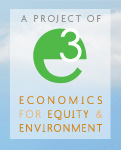My last blog post discussed issues of efficiency and fairness in climate policy. Specifically, it showed how climate policy can achieve one without the other. From an economic standpoint, fairness is irrelevant to designing an effective and efficient policy tool. It’s not that economists don’t like fairness, but it exists at a right angle to efficiency, which economists tend to like more.
In the real world, fairness matters a lot, and efficiency often gets second billing. This is both good and bad. I’m not sure even economists would want to live in a world where everything was efficient but nothing was fair. But it also means that sometimes we have to sacrifice efficiency (and accept higher costs) to achieve fairness. This is not always the case, and one of the main reasons the E3 Network was formed is to develop and highlight policy solutions that can achieve both, as well as to make the case that fairness deserves at least equal billing. This might sound like common sense, but I promise you it’s heresy in many economic debates.
This tension will be the subject of a lot of the discussions on Real Climate Economics, but before I get into those issues, there are a few more basics I’d like to get on paper.
One of the most important ones is the relationship between prices and quantities. These ideas were formalized by Martin Weitzman in his seminal article “Prices vs Quantities” in the Review of Economic Studies, (1974, v. 41 no 4) to whom we owe a debt of gratitude.
The first thing to keep in mind is that, in a market setting, prices and quantities are opposite sides of the same coin. While there is not a strict one-to-one relationship, there is a close correlation between the quantity of a good or service in a market and the price it sells for. For example, most everyone knows that OPEC plays a major role in setting (or at least influencing) global oil prices. The truth is that OPEC can’t directly influence prices. Rather, they try to hit their price targets by changing oil production levels. Since they are responsible for about 40% of global oil production, if they make large changes in their production rates, global prices react. When they cut output significantly, prices go up and vice-versa.
In a perfect world, if we knew how much damage one ton’s worth of carbon emissions would cause (and assuming we could put a dollar value on the damage), then climate policy would be economically straightforward: just require polluters to pay that cost for every ton they emit. Unlike OPEC and oil, we can set carbon prices directly, by taxing carbon.
In reality, we don’t really know what the cost to society is of an additional ton of carbon emissions, so we don’t know what the right price is. One response to this problem is to ask how much carbon can be safely emitted each year, and restrict annual emissions to that level. If we do that, the right to emit carbon will become more scarce (like oil does when OPEC cuts production), and people will be willing to pay more for that right depending on how scarce it is. The right to emit will take on a price as polluters buy and sell those rights among one another.
In an economically perfect world, there would be no difference between these two options. Ideally, we would know exactly what the cost of carbon emissions are and we could either set a carbon tax at that rate, or we could set the level of allowable emissions at a level that would generate that price through a private market.
In reality, of course, there is a difference. We don’t know what the cost of carbon emissions are, and if we wanted to target a specific price, we wouldn’t know how much emissions to allow to hit that price.
This brings us to one the most hotly contested issues in climate policy: carbon taxes versus cap and trade. Many economists have a habit of scratching their heads at this debate. In our idealized world, if you set the quantity you get a carbon price, and if you set the carbon price you get a quantity. The choice of which mechanism to use is largely a question of which one we could control at the lowest cost and with the most certainty. That is still fundamentally true, but that analysis abstracts from so many of the important questions, that it’s almost meaningless.
Take risk as just one example. With carbon emissions, its not terribly important from a scientific standpoint, how high or low we price carbon. What is important is the amount of carbon that gets emitted. So if policymakers are more concerned with the risk of emitting too much carbon, it makes sense to set a limit on the amount of carbon that gets emitted and not worry about what the price is. This is the basis of emissions trading systems like cap and trade. From a business person’s point of view, however, it might be more important that the cost per ton of carbon remain below a certain level or even at one particular level so that she can make long-term capital and investment decisions without worrying about the price of carbon going up or down unexpectedly. This is one of the arguments for a carbon tax.
There is a lot more to the taxes versus cap and trade debate than just this, and those will be appear often in my posts and elsewhere on realclimateeconomics.org, but the relationship between prices and quantities is a fundamental part of most of them. The choice between whether we try to set carbon prices through a tax or limit carbon quantities through some type of emissions trading system is an incredibly important decision that touches on a number of fundamental questions around fairness, efficiency, and politics.

